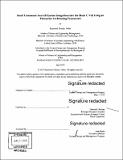| dc.contributor.advisor | Donna H. Rhodes. | en_US |
| dc.contributor.author | Vetter, Raymond Thomas. | en_US |
| dc.contributor.other | Massachusetts Institute of Technology. Engineering and Management Program. | en_US |
| dc.contributor.other | System Design and Management Program. | en_US |
| dc.date.accessioned | 2019-09-17T19:51:14Z | |
| dc.date.available | 2019-09-17T19:51:14Z | |
| dc.date.copyright | 2019 | en_US |
| dc.date.issued | 2019 | en_US |
| dc.identifier.uri | https://hdl.handle.net/1721.1/122260 | |
| dc.description | Thesis: S.M. in Engineering and Management, Massachusetts Institute of Technology, System Design and Management Program, 2019 | en_US |
| dc.description | Cataloged from PDF version of thesis. | en_US |
| dc.description | Includes bibliographical references (pages 152-159). | en_US |
| dc.description.abstract | Integrating small unmanned aerial systems (sUAS) into the national airspace system (NAS) represents a challenging problem set that requires consideration through multiple lenses. Like most complex problems, considering one class of constraints is inadequate to developing a solution that satisfies all interested stakeholders. Rather than focusing solely on the technological limitations of sUAS operation, this work employs the Architecting Innovative Enterprise Strategy (ARIES) Framework to understand the current and future landscapes for the NAS. This work considers the ecosystem that influences the NAS and the key stakeholders with decision-making authority. The author uses the ARIES elements (strategy, information, infrastructure, products, services, processes, organizations, and knowledge) to holistically describe the current architecture that allows for very limited sUAS operations in the Mode C Veil. | en_US |
| dc.description.abstract | After considering the ongoing efforts to integrate sUAS into the NAS, the envisioned future describes how the enterprise may transform under ideal conditions. This thesis incorporates aspects of the current architecture for sUAS operations and provides a recommended future architecture that expands sUAS use. By identifying current limitations and incorporating emerging mitigation techniques, the author is able to develop and evaluate different alternatives. These alternatives seek to address externalities that emerge from the increased use of sUAS in close proximity to the general public. Such externalities include safety, security, privacy, and transparency concerns. The recommended future architecture relies on airborne systems to detect and avoid manned aircraft and utilizes an unmanned traffic management system for information sharing and flight coordination. | en_US |
| dc.description.abstract | This architecture requires significant investment in developing a shared database to manage unmanned vehicle operations, but provides the structure and functions required to make sUAS operations feasible when considering constraints, externalities, and public acceptance. | en_US |
| dc.description.statementofresponsibility | by Raymond Thomas Vetter. | en_US |
| dc.format.extent | 159 pages | en_US |
| dc.language.iso | eng | en_US |
| dc.publisher | Massachusetts Institute of Technology | en_US |
| dc.rights | MIT theses are protected by copyright. They may be viewed, downloaded, or printed from this source but further reproduction or distribution in any format is prohibited without written permission. | en_US |
| dc.rights.uri | http://dspace.mit.edu/handle/1721.1/7582 | en_US |
| dc.subject | Engineering and Management Program. | en_US |
| dc.subject | System Design and Management Program. | en_US |
| dc.title | Small unmanned aircraft system integration into the Mode C Veil using an enterprise architecting framework | en_US |
| dc.title.alternative | sUAS integration into the Mode C Veil using an enterprise architecting framework | en_US |
| dc.type | Thesis | en_US |
| dc.description.degree | S.M. in Engineering and Management | en_US |
| dc.contributor.department | Massachusetts Institute of Technology. Engineering and Management Program | en_US |
| dc.identifier.oclc | 1119555556 | en_US |
| dc.description.collection | S.M.inEngineeringandManagement Massachusetts Institute of Technology, System Design and Management Program | en_US |
| dspace.imported | 2019-09-17T19:51:12Z | en_US |
| mit.thesis.degree | Master | en_US |
| mit.thesis.department | SysDes | en_US |
